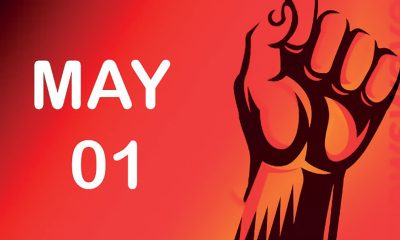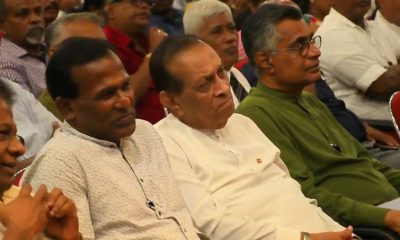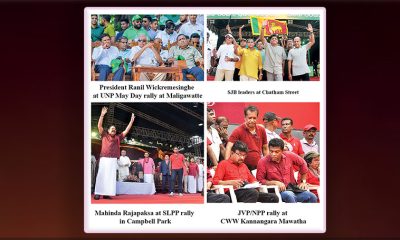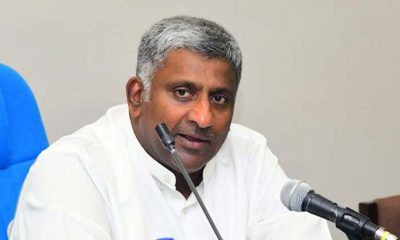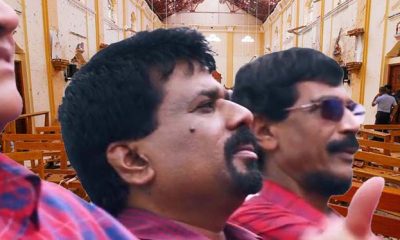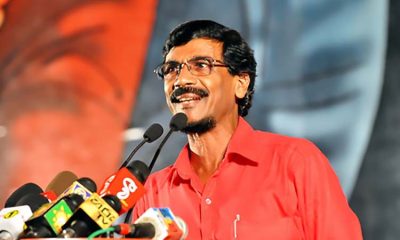Features
The Gunner Platoon at Weerawila Down South in 1971 – combating the JVP Insurgency

A personal story as recalled by Capt F.R.A.B. Musafer 4th Regt SLA (Retd)
Background
The year 1971 was ushered in with a very pleasing political utterance to the public that the Army did not need guns but needed plowshares – agricultural machinery and tools to support the food drive. It was at a time when the Army, an essentially peacetime operation entrusted with the internal security of the country, had turned its attention to assist with national paddy cultivation and other agricultural projects countrywide.
With an estimated strength of around 8,000, the army was not a well equipped force by any means. It was frugal in outlook and dependent on existing resources. The military hardware was virtually hand-me-downs of the British Army and of World War II vintage. The bulk of the small arms in use were the old .303 Enfield rifles the rest were made up of light machine gun (LMG), sten gun (SMC) and the sterling sub machine gun (SMG) and the .38 Smith and Wesson pistols. The infantry units were being re-equipped with the 7.62 mm self loading rifle (SLR’s), a sophisticated and automated weapon in use by the British Army.
The Armoured corp was the glamour regiment equipped with Ferret scout cars and Daimler armoured cars that were impressive and operational. The Artillery regiment had four 76mm mountain guns gifted by Yugoslavia that were also operational, though the need for their use was considered far fetched. The regiment also had a battery of 3.7 inch anti-aircraft guns used for ceremonial gun salutes and a battery of 40mm Bofor anti-aircraft guns that were obsolete.
The army was subjected to a fair share of austerity as was the rest of the country; petrol was issued on a quota basis, the use of ammunition for training strictly monitored and some basic military essentials hard to come by.
The State of the Nation
In May 1970 the Sri Lanka Freedom Party under the leadership of Mrs Sirima Bandaranaike was swept into power with an overwhelming majority with the help of the left parties with whom the SLFP ran as a United Front (UF). The JVP, though not a political party, gave its support to the coalition as it was socialist in outlook and totally opposed to the capitalist ideologies of the United National Party.
The victory instilled in the people a new hope and they labeled it as the “Apey Anduwa” (Our Government) hoping that there would be an improvement to their lives. However as time progressed the hardships faced by the people did not appear to improve as the economic situation only worsened. Strict import and exchange control regulations were in place. Basic items such as bread, sugar, dhal and infant milk were rationed. Food, clothing and vegetables were expensive if not scarce. The transport of rice and chillies was prohibited. The cost of living had sky rocketed and the people feeling its effects were a disillusioned lot .
The Prelude
At the beginning of 1971 there were instances of bombs accidentally going off in various parts of the country predominantly in the Kegalle and Kandy districts. The roof of one of the buildings in the Peradeniya campus was damaged as a result of one of these explosions. Mixed signals were beginning to emerge that there was trouble brewing and the JVP, often dubbed the Che Guevara Movement, was behind the plans to initiate an armed insurrection. Intelligence gathered by the police revealed that the JVP was operating via a network of cells where members were indoctrinated by “Five Lectures” and directed to collect firearms and funds by robbing banks and individuals. Political rallies and clandestine meetings held by the JVP were gathering momentum and causing some serious concern to the government.
Around the beginning of March security around the Army cantonment at Panagoda was strengthened. Rumour was rife that there were elements of officers and soldiers sympathetic to the cause, if not members of the JVP. Extra precautions were taken to double the security of the arms and ammunition held in the camps. There was an air of suspicion and a lack of trust among the rank and file. There was also some concern that food and water was to be poisoned, so much so that the stray dogs in certain camps were fed before the troops.
In mid March a state of Emergency was declared with special powers of search without a warrant being entrusted to the Police. In conjunction with this the Army was to be deployed to assist the Police in search and cordon operations. Captain Satchi Ratnasabapathy from the Regiment of Artillery was sent to Hambantota to reconnoiter the area and liaise with the Police and Government Agent to assess the threats posed in the event of any actions initiated by the JVP that would disrupt the internal security of the region.
Meanwhile suspected high profile JVP activists and their leader Rohana Wijeweera were arrested and imprisoned in Jaffna. There was an assumption that the “Che Guevara” as they were referred to had plenty of sympathizers and supporters as there were several well attended, popular public meetings conducted in the Hambantota region. Intelligence reported that secret meetings of cell members were being held and basic military type training was being given to trusted cadres. JVP plans to collect weapons and raise funds by robberies etc were not taken seriously and pursued. The Hambantota/Tissamaharama district was considered to be a hotbed of JVP activity and identified as one of the most likely trouble spots in the island.
The deployment
At that time I was a lieutenant posted to 10 Battery at Trincomalee but was temporarily stationed at Panagoda in preparation for the Army inter-unit rugby tournament. On the evening of March 15 whilst at rugby practices I was summoned by the adjutant, Capt Siri Samarakoon, to his office where he told me in a voice dripping with sarcasm that I had won the lottery and was to take an IS (Internal Security) platoon and leave for Weerawila in the Hambantota district at the crack of dawn on March 17.
At the same time two artillery platoons from Trincomalee under the command of Capt Tissa Tillekeratne and Lt Lionel Balagalla were also to be deployed to Polonnaruwa and Hingurakgoda. There were other deployments to the Kegalle, Kandy, Anuradhpura and Moneragala districts from infantry and armoured corp detachments.
. On March 16 I was given my operational orders. I was also briefed by Capt Ratnasabapathy who assured me that based on local intelligence provided by the police he was of opinion that there was NO significant information of violent JVP activity in the Hambantota area but cautioned me about the wild elephants that roamed in the vicinity of the salt pans at night.
The platoon consisted of 31 men, which included three sergeants as section commanders and a cook. The platoon was armed with .303 rifles. A light machine gun (LMG) and three sterling sub machine guns (SMG) . As an officer I had the least effective weapon, a Smith and Wesson .38 calibre pistol that was more of a status symbol of authority. I was also issued with a sealed box of a thousand rounds of .303 ammunition with strict instructions not to break the seal unless absolutely necessary. It was also emphasized that I be very mindful of my personal security and that of the weapons at all times.
My transport was an old Willys jeep AY 3665 which on independence day parades looked very impressive, freshly painted with its windscreen down and hood taken off although it was patched up with paper and spray painted over to hide the rust and holes. There were three trucks detailed to carry the troops of which one would return to camp and the other, a new Indian five ton Tata Benz and a Beep (smaller version of a truck), to be used for operations. I was to be supplied with additional transport by the Government Agent Hambantota on my arrival in Weerawila.
On March 17 morning I left Panagoda at the crack of dawn having been bid farewell by Captain Noel Weerakoon who was the Battery commander of 11 Battery whose men I had taken charge of. He wished me “Good luck and God bless and take care of yourself “. Sadly it was a last farewell. He was killed in an ambush on April 8 at Ambewewa/Welioya. I think he was the first officer of the Army to be killed in action in this conflict and perhaps in the short history of the Ceylon Army.
The designated route was via Ratnapura and en-route we stopped at an army camp at Embilipitiya. The soldiers here had conveyed to some of the platoon that there were threats made of possible attacks on the camp via open postcards and were on extra guard duty.
Our base at Weerawila was to be the Old Tuberculosis hospital complex which had been uninhabited and abandoned. The GA and his staff had done their best to make this building habitable by restoring electricity and water.
The building we occupied, devoid of any furniture or fittings, was located in the middle of nowhere, isolated and off the main road and surrounded by dense overgrown shrub. In unfamiliar surroundings and not feeling secure I came to the conclusion that I could take no chances of being taken by surprise. The first thing I did was to disregard my orders and break the sealed box of ammunition and distribute some of it to the men and instruct them to keep their weapons by their side at all times.
Espirit de Corps and loyalty of the Regiment
It was a decision I made taking into consideration the utmost trust and loyalty of the soldiers under my command. “The Gunners” as those belonging to the regiment of artillery are generally referred to, were a close knit family (the gunner tribe) . Their loyalty and espirit de corps were always talked about in the army, best described in a message in the centenary celebrations of the Artillery in Sri Lanka in 1988 by the late Lt General Nalin Seniviratne, the commander of the army which said as follows:
“In the rich and colourful tapestry of Gunner history, an unbroken golden thread that runs across the entire fabric is that vibrant vitality of the Regiment, is their sense of unity and their espirit-de- corps “.
” Gunners are a unique family; in our family we the officers are very close to our men. The well being of our men has always been close to our hearts. We are proud of them,” as said by Lt Gen Hamilton Wanasinghe a gunner and a former Army commander would aptly describe the relationship we enjoyed. It was a unique bond between the officers and the men which made my decision so much easier at this time of great doubt and suspicion.
At Weerawila
Late in the evening two soldiers from the Ridiyagama farm that was being dismantled turned up and requested a guard. They too had received open postcards that their camp was to be attacked but had no weapons to defend themselves. I obliged by detailing two men. Unfortunately it became a daily assignment and was seen as a punishment chore. Weerawila was to be our home and operational base.
On March 18 I reported to The Government Agent Hambantota, Mr Sonny Goonewardene, who briefed me on the situation and reiterated that even though a state of emergency had been declared I was there only to assist the police and had no other powers. I was to work in liaison with the Assistant Superintendent of Police Tangalle, Mr Jim Bandaranayake who would coordinate my daily activities, in the absence of the ASP Hambantota. I was provided with two additional vehicles with civilian drivers to carry out my tasks.
The presence of the army in the Hambantota district may have intrigued the general public curious about why we were there. It was after a long time that the public had seen an army deployment in their locality and were perhaps bemused at the gun toting soldiers. The last time a military operation conducted in the Hambantota/ Tanamalwila area was in the late 1950’s named ‘Operation Ganja” where armoured cars and troops were used to destroy illicit ganja plantations in Tanamalwila and surrounding areas.
It was an operation made infamous for the unsuccessful legal action taken to prosecute Lt. Eustace Fonseka, a gunner officer, for the ill treatment meted out to the village headman of Hambegamuwa. who was alleged to be the mastermind and king pin of the ganja cultivation in the area. This operation was of a different nature.
Whilst we made our presence felt and were quite friendly the locals kept a fair distance from us wondering what the hell was going on.
Commencement of Operations /Searches
Initially we assisted the police traveling around the countryside in the military vehicles displaying our weapons which the police did not carry. We accompanied them to search homes of people suspected of involvement with the JVP. There was hardly any credible intelligence as most of our searches were more of a routine show of force and nothing else. There was no intimidation of the general public and not a single arrest was made in these joint operations.
One day when accompanied by the police sergeant at Walasmulla I observed that he was using these searches to intimidate some people whose political alliances were not the same as the govt in power. Every home and shop he took us into had a photograph of the former prime minister. It was not the first time this had happened but the continuation of this routine irked me.
This was not something that I could tolerate or an action that I could condone as it was in breach of my orders and furthermore the searches were fruitless. I contacted ASP Jim Bandaranayake and told him what was happening and that I was not prepared to assist the Police any further if this was all the intelligence they had.
Incidentally some months after the insurgency had been quelled the sergeant concerned was charged for the murder of some insurgents who were fleeing from army operations in the Sinharaja and Deniyaya areas being conducted by the army. They had been taken into custody by the police and on the pretext of being released shot and buried in a mass grave.
We continued to patrol and make our presence felt in Beliatta , Middeniya, Walasmulla, Ambalantota, Tangalle, Tissa, Kirinda and Hambantota with the assistance of the Police. We searched Wijeweera’s home in Tangalle occupied by his mother and sister. There were magazines titled ” Red China” and nothing else in this very clean and neatly kept house. This magazine was found in a number of places we searched including temples. His mother told us that she detested what her son was doing and had advised him to keep clear of politics. He had been arrested and imprisoned in Jaffna. They had a small poultry shed which I presumed gave them some sort of income.
Whilst there was very little of any material evidence to support an armed insurrection we did come across some very personal revelations. There was an instance when we found a diary of a person who had virtually kept a daily record of his sexual exploits in an affair with a girl across the road. The Kama Sutra may have been his manual. The sergeant who found the diary did not find the contents to his moral satisfaction darted across the road to the school nearby and divulged the contents to the head master. His audience showed no concern as perhaps they knew what had been taking place but were no doubt amused by the colourfully detailed narrative.
(To be continued next weekweek)
Features
The heart-friendly health minister

by Dr Gotabhya Ranasinghe
Senior Consultant Cardiologist
National Hospital Sri Lanka
When we sought a meeting with Hon Dr. Ramesh Pathirana, Minister of Health, he graciously cleared his busy schedule to accommodate us. Renowned for his attentive listening and deep understanding, Minister Pathirana is dedicated to advancing the health sector. His openness and transparency exemplify the qualities of an exemplary politician and minister.
Dr. Palitha Mahipala, the current Health Secretary, demonstrates both commendable enthusiasm and unwavering support. This combination of attributes makes him a highly compatible colleague for the esteemed Minister of Health.
Our discussion centered on a project that has been in the works for the past 30 years, one that no other minister had managed to advance.
Minister Pathirana, however, recognized the project’s significance and its potential to revolutionize care for heart patients.
The project involves the construction of a state-of-the-art facility at the premises of the National Hospital Colombo. The project’s location within the premises of the National Hospital underscores its importance and relevance to the healthcare infrastructure of the nation.
This facility will include a cardiology building and a tertiary care center, equipped with the latest technology to handle and treat all types of heart-related conditions and surgeries.
Securing funding was a major milestone for this initiative. Minister Pathirana successfully obtained approval for a $40 billion loan from the Asian Development Bank. With the funding in place, the foundation stone is scheduled to be laid in September this year, and construction will begin in January 2025.
This project guarantees a consistent and uninterrupted supply of stents and related medications for heart patients. As a result, patients will have timely access to essential medical supplies during their treatment and recovery. By securing these critical resources, the project aims to enhance patient outcomes, minimize treatment delays, and maintain the highest standards of cardiac care.
Upon its fruition, this monumental building will serve as a beacon of hope and healing, symbolizing the unwavering dedication to improving patient outcomes and fostering a healthier society.We anticipate a future marked by significant progress and positive outcomes in Sri Lanka’s cardiovascular treatment landscape within the foreseeable timeframe.
Features
A LOVING TRIBUTE TO JESUIT FR. ALOYSIUS PIERIS ON HIS 90th BIRTHDAY

by Fr. Emmanuel Fernando, OMI
Jesuit Fr. Aloysius Pieris (affectionately called Fr. Aloy) celebrated his 90th birthday on April 9, 2024 and I, as the editor of our Oblate Journal, THE MISSIONARY OBLATE had gone to press by that time. Immediately I decided to publish an article, appreciating the untiring selfless services he continues to offer for inter-Faith dialogue, the renewal of the Catholic Church, his concern for the poor and the suffering Sri Lankan masses and to me, the present writer.
It was in 1988, when I was appointed Director of the Oblate Scholastics at Ampitiya by the then Oblate Provincial Fr. Anselm Silva, that I came to know Fr. Aloy more closely. Knowing well his expertise in matters spiritual, theological, Indological and pastoral, and with the collaborative spirit of my companion-formators, our Oblate Scholastics were sent to Tulana, the Research and Encounter Centre, Kelaniya, of which he is the Founder-Director, for ‘exposure-programmes’ on matters spiritual, biblical, theological and pastoral. Some of these dimensions according to my view and that of my companion-formators, were not available at the National Seminary, Ampitiya.
Ever since that time, our Oblate formators/ accompaniers at the Oblate Scholasticate, Ampitiya , have continued to send our Oblate Scholastics to Tulana Centre for deepening their insights and convictions regarding matters needed to serve the people in today’s context. Fr. Aloy also had tried very enthusiastically with the Oblate team headed by Frs. Oswald Firth and Clement Waidyasekara to begin a Theologate, directed by the Religious Congregations in Sri Lanka, for the contextual formation/ accompaniment of their members. It should very well be a desired goal of the Leaders / Provincials of the Religious Congregations.
Besides being a formator/accompanier at the Oblate Scholasticate, I was entrusted also with the task of editing and publishing our Oblate journal, ‘The Missionary Oblate’. To maintain the quality of the journal I continue to depend on Fr. Aloy for his thought-provoking and stimulating articles on Biblical Spirituality, Biblical Theology and Ecclesiology. I am very grateful to him for his generous assistance. Of late, his writings on renewal of the Church, initiated by Pope St. John XX111 and continued by Pope Francis through the Synodal path, published in our Oblate journal, enable our readers to focus their attention also on the needed renewal in the Catholic Church in Sri Lanka. Fr. Aloy appreciated very much the Synodal path adopted by the Jesuit Pope Francis for the renewal of the Church, rooted very much on prayerful discernment. In my Religious and presbyteral life, Fr.Aloy continues to be my spiritual animator / guide and ongoing formator / acccompanier.
Fr. Aloysius Pieris, BA Hons (Lond), LPh (SHC, India), STL (PFT, Naples), PhD (SLU/VC), ThD (Tilburg), D.Ltt (KU), has been one of the eminent Asian theologians well recognized internationally and one who has lectured and held visiting chairs in many universities both in the West and in the East. Many members of Religious Congregations from Asian countries have benefited from his lectures and guidance in the East Asian Pastoral Institute (EAPI) in Manila, Philippines. He had been a Theologian consulted by the Federation of Asian Bishops’ Conferences for many years. During his professorship at the Gregorian University in Rome, he was called to be a member of a special group of advisers on other religions consulted by Pope Paul VI.
Fr. Aloy is the author of more than 30 books and well over 500 Research Papers. Some of his books and articles have been translated and published in several countries. Among those books, one can find the following: 1) The Genesis of an Asian Theology of Liberation (An Autobiographical Excursus on the Art of Theologising in Asia, 2) An Asian Theology of Liberation, 3) Providential Timeliness of Vatican 11 (a long-overdue halt to a scandalous millennium, 4) Give Vatican 11 a chance, 5) Leadership in the Church, 6) Relishing our faith in working for justice (Themes for study and discussion), 7) A Message meant mainly, not exclusively for Jesuits (Background information necessary for helping Francis renew the Church), 8) Lent in Lanka (Reflections and Resolutions, 9) Love meets wisdom (A Christian Experience of Buddhism, 10) Fire and Water 11) God’s Reign for God’s poor, 12) Our Unhiddden Agenda (How we Jesuits work, pray and form our men). He is also the Editor of two journals, Vagdevi, Journal of Religious Reflection and Dialogue, New Series.
Fr. Aloy has a BA in Pali and Sanskrit from the University of London and a Ph.D in Buddhist Philosophy from the University of Sri Lankan, Vidyodaya Campus. On Nov. 23, 2019, he was awarded the prestigious honorary Doctorate of Literature (D.Litt) by the Chancellor of the University of Kelaniya, the Most Venerable Welamitiyawe Dharmakirthi Sri Kusala Dhamma Thera.
Fr. Aloy continues to be a promoter of Gospel values and virtues. Justice as a constitutive dimension of love and social concern for the downtrodden masses are very much noted in his life and work. He had very much appreciated the commitment of the late Fr. Joseph (Joe) Fernando, the National Director of the Social and Economic Centre (SEDEC) for the poor.
In Sri Lanka, a few religious Congregations – the Good Shepherd Sisters, the Christian Brothers, the Marist Brothers and the Oblates – have invited him to animate their members especially during their Provincial Congresses, Chapters and International Conferences. The mainline Christian Churches also have sought his advice and followed his seminars. I, for one, regret very much, that the Sri Lankan authorities of the Catholic Church –today’s Hierarchy—- have not sought Fr.
Aloy’s expertise for the renewal of the Catholic Church in Sri Lanka and thus have not benefited from the immense store of wisdom and insight that he can offer to our local Church while the Sri Lankan bishops who governed the Catholic church in the immediate aftermath of the Second Vatican Council (Edmund Fernando OMI, Anthony de Saram, Leo Nanayakkara OSB, Frank Marcus Fernando, Paul Perera,) visited him and consulted him on many matters. Among the Tamil Bishops, Bishop Rayappu Joseph was keeping close contact with him and Bishop J. Deogupillai hosted him and his team visiting him after the horrible Black July massacre of Tamils.
Features
A fairy tale, success or debacle

Sri Lanka-Singapore Free Trade Agreement
By Gomi Senadhira
senadhiragomi@gmail.com
“You might tell fairy tales, but the progress of a country cannot be achieved through such narratives. A country cannot be developed by making false promises. The country moved backward because of the electoral promises made by political parties throughout time. We have witnessed that the ultimate result of this is the country becoming bankrupt. Unfortunately, many segments of the population have not come to realize this yet.” – President Ranil Wickremesinghe, 2024 Budget speech
Any Sri Lankan would agree with the above words of President Wickremesinghe on the false promises our politicians and officials make and the fairy tales they narrate which bankrupted this country. So, to understand this, let’s look at one such fairy tale with lots of false promises; Ranil Wickremesinghe’s greatest achievement in the area of international trade and investment promotion during the Yahapalana period, Sri Lanka-Singapore Free Trade Agreement (SLSFTA).
It is appropriate and timely to do it now as Finance Minister Wickremesinghe has just presented to parliament a bill on the National Policy on Economic Transformation which includes the establishment of an Office for International Trade and the Sri Lanka Institute of Economics and International Trade.
Was SLSFTA a “Cleverly negotiated Free Trade Agreement” as stated by the (former) Minister of Development Strategies and International Trade Malik Samarawickrama during the Parliamentary Debate on the SLSFTA in July 2018, or a colossal blunder covered up with lies, false promises, and fairy tales? After SLSFTA was signed there were a number of fairy tales published on this agreement by the Ministry of Development Strategies and International, Institute of Policy Studies, and others.
However, for this article, I would like to limit my comments to the speech by Minister Samarawickrama during the Parliamentary Debate, and the two most important areas in the agreement which were covered up with lies, fairy tales, and false promises, namely: revenue loss for Sri Lanka and Investment from Singapore. On the other important area, “Waste products dumping” I do not want to comment here as I have written extensively on the issue.
1. The revenue loss
During the Parliamentary Debate in July 2018, Minister Samarawickrama stated “…. let me reiterate that this FTA with Singapore has been very cleverly negotiated by us…. The liberalisation programme under this FTA has been carefully designed to have the least impact on domestic industry and revenue collection. We have included all revenue sensitive items in the negative list of items which will not be subject to removal of tariff. Therefore, 97.8% revenue from Customs duty is protected. Our tariff liberalisation will take place over a period of 12-15 years! In fact, the revenue earned through tariffs on goods imported from Singapore last year was Rs. 35 billion.
The revenue loss for over the next 15 years due to the FTA is only Rs. 733 million– which when annualised, on average, is just Rs. 51 million. That is just 0.14% per year! So anyone who claims the Singapore FTA causes revenue loss to the Government cannot do basic arithmetic! Mr. Speaker, in conclusion, I call on my fellow members of this House – don’t mislead the public with baseless criticism that is not grounded in facts. Don’t look at petty politics and use these issues for your own political survival.”
I was surprised to read the minister’s speech because an article published in January 2018 in “The Straits Times“, based on information released by the Singaporean Negotiators stated, “…. With the FTA, tariff savings for Singapore exports are estimated to hit $10 million annually“.
As the annual tariff savings (that is the revenue loss for Sri Lanka) calculated by the Singaporean Negotiators, Singaporean $ 10 million (Sri Lankan rupees 1,200 million in 2018) was way above the rupees’ 733 million revenue loss for 15 years estimated by the Sri Lankan negotiators, it was clear to any observer that one of the parties to the agreement had not done the basic arithmetic!
Six years later, according to a report published by “The Morning” newspaper, speaking at the Committee on Public Finance (COPF) on 7th May 2024, Mr Samarawickrama’s chief trade negotiator K.J. Weerasinghehad had admitted “…. that forecasted revenue loss for the Government of Sri Lanka through the Singapore FTA is Rs. 450 million in 2023 and Rs. 1.3 billion in 2024.”
If these numbers are correct, as tariff liberalisation under the SLSFTA has just started, we will pass Rs 2 billion very soon. Then, the question is how Sri Lanka’s trade negotiators made such a colossal blunder. Didn’t they do their basic arithmetic? If they didn’t know how to do basic arithmetic they should have at least done their basic readings. For example, the headline of the article published in The Straits Times in January 2018 was “Singapore, Sri Lanka sign FTA, annual savings of $10m expected”.
Anyway, as Sri Lanka’s chief negotiator reiterated at the COPF meeting that “…. since 99% of the tariffs in Singapore have zero rates of duty, Sri Lanka has agreed on 80% tariff liberalisation over a period of 15 years while expecting Singapore investments to address the imbalance in trade,” let’s turn towards investment.
Investment from Singapore
In July 2018, speaking during the Parliamentary Debate on the FTA this is what Minister Malik Samarawickrama stated on investment from Singapore, “Already, thanks to this FTA, in just the past two-and-a-half months since the agreement came into effect we have received a proposal from Singapore for investment amounting to $ 14.8 billion in an oil refinery for export of petroleum products. In addition, we have proposals for a steel manufacturing plant for exports ($ 1 billion investment), flour milling plant ($ 50 million), sugar refinery ($ 200 million). This adds up to more than $ 16.05 billion in the pipeline on these projects alone.
And all of these projects will create thousands of more jobs for our people. In principle approval has already been granted by the BOI and the investors are awaiting the release of land the environmental approvals to commence the project.
I request the Opposition and those with vested interests to change their narrow-minded thinking and join us to develop our country. We must always look at what is best for the whole community, not just the few who may oppose. We owe it to our people to courageously take decisions that will change their lives for the better.”
According to the media report I quoted earlier, speaking at the Committee on Public Finance (COPF) Chief Negotiator Weerasinghe has admitted that Sri Lanka was not happy with overall Singapore investments that have come in the past few years in return for the trade liberalisation under the Singapore-Sri Lanka Free Trade Agreement. He has added that between 2021 and 2023 the total investment from Singapore had been around $162 million!
What happened to those projects worth $16 billion negotiated, thanks to the SLSFTA, in just the two-and-a-half months after the agreement came into effect and approved by the BOI? I do not know about the steel manufacturing plant for exports ($ 1 billion investment), flour milling plant ($ 50 million) and sugar refinery ($ 200 million).
However, story of the multibillion-dollar investment in the Petroleum Refinery unfolded in a manner that would qualify it as the best fairy tale with false promises presented by our politicians and the officials, prior to 2019 elections.
Though many Sri Lankans got to know, through the media which repeatedly highlighted a plethora of issues surrounding the project and the questionable credentials of the Singaporean investor, the construction work on the Mirrijiwela Oil Refinery along with the cement factory began on the24th of March 2019 with a bang and Minister Ranil Wickremesinghe and his ministers along with the foreign and local dignitaries laid the foundation stones.
That was few months before the 2019 Presidential elections. Inaugurating the construction work Prime Minister Ranil Wickremesinghe said the projects will create thousands of job opportunities in the area and surrounding districts.
The oil refinery, which was to be built over 200 acres of land, with the capacity to refine 200,000 barrels of crude oil per day, was to generate US$7 billion of exports and create 1,500 direct and 3,000 indirect jobs. The construction of the refinery was to be completed in 44 months. Four years later, in August 2023 the Cabinet of Ministers approved the proposal presented by President Ranil Wickremesinghe to cancel the agreement with the investors of the refinery as the project has not been implemented! Can they explain to the country how much money was wasted to produce that fairy tale?
It is obvious that the President, ministers, and officials had made huge blunders and had deliberately misled the public and the parliament on the revenue loss and potential investment from SLSFTA with fairy tales and false promises.
As the president himself said, a country cannot be developed by making false promises or with fairy tales and these false promises and fairy tales had bankrupted the country. “Unfortunately, many segments of the population have not come to realize this yet”.
(The writer, a specialist and an activist on trade and development issues . )



